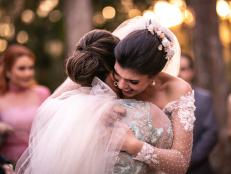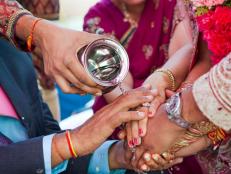Unique Wedding Traditions from 30 Different Countries
A peek inside wedding ceremonies around the world.

Worldly Traditions
Every country is home to an array of cultures with unique wedding traditions and customs. See how brides and grooms around the world celebrate each other and their union.
Japan: Bonding Over Sake
During a traditional ceremony, Japanese couples share sake – Japanese rice wine – in a ritual known as san-san-kudo. Three cups of sake cups are stacked on top of each other, and the bride and groom both take three sips from each. Their parents follow behind them, all taking 3 sips as well, which represents a formal bond behind created and upheld between the families.
Guatemala: Breaking the Bell
During Guatemalan wedding receptions, the mother of the groom has the important job of breaking a white bell that is filled with flour, rice and grains. The shattering serves as a welcome to the newlyweds as they come into the party and is meant to bring them both luck and prosperity.
India: Henna
Henna is painted on an Indian bride’s hands and feet the night before her wedding during a Mehndi ceremony with her family members. The designs represent joy, beauty and spiritual awakening.
Lebanon: Zaffe
It’s time to party, and party some more! A zaffe is held at both the bride and groom’s homes before the wedding ceremony. The large event is full of fun, cheer, dancing and celebration.
Philippines: Release the Doves
Doves are the symbol of peace and harmony, and the same goes at a wedding in the Philippines. During the reception, a caged male and female dove are released by the bride and groom when they pull a door-opening cord together. The bird takes flight, and so does their marriage.
Venezuela: The Disappearing Couple
Sometimes weddings can be long, and you just want to start life with the one you love. At a Venezuelan wedding, it is not uncommon for the bride and groom to slip away before the end of their reception. Successfully getting away unnoticed is thought to bring good luck, and the first person to notice they are missing will receive such luck as well.
Germany: Sawing a Log in Half
Newlyweds will face many obstacles as they move through life together and come out stronger because of it. During a Baumstamm Sägen, the German tradition where a new couple saws a log in half together, each grab one side of the handle and works until the job is complete. This is their first obstacle they overcome together and families cheer on the sidelines to show their support.
Wales: Myrtle for the Bridesmaids
Welsh brides carry myrtle leaves in their bouquet and offers a cut to each of her bridesmaids. According to lore, bridesmaids should take the myrtle home, plant it and, if it blooms, she will be the next lucky friend to wed.
Kate Middleton, who is the likely next Queen consort of the U.K. and commonwealth countries, adopted the traidition when marrying Prince William.
Ireland: Keep One Foot on the Ground
We love a grounded bride. In Ireland, the first dance between a bride and groom is beautiful with a side of pressure. The bride is tasked with keeping at least one of her feet on the ground at both times. If both were to lift, she could be taken away by fairies.
Namibia: Kidnapping for Fashion
Friends of a Himba bride in Namibia are known for kidnapping the star of the day and tending to her fashionable side. The bride is put in a headdress, known as an okori, and lovingly covered in herbs, butterfat and expensive jewelry.
Greece: A Clean Shave
Nobody wants an overly scruffy groom. In Greece, the best man, known as the koumbaro, proves his trustworthiness by shaving the groom’s face before the ceremony. Others in the crew finish the job by helping him dress for the big day.
Cuba: The Money Dance
Weddings can be expensive, but couples in Cuba have it covered! After the wedding ceremony, where family and friends dance and celebrate with the newlyweds, men who wish to steal a dance with the bride have to pay a fee. During a dance, the male wedding goer will pin money to the bride’s dress to help pay for the couple’s honeymoon and future.
French Polynesia: Stepping Stones
A supportive family can be the backbone that upholds any great relationship–and literally so in the islands of French Polynesia. At the end of a wedding, the bride’s family members will lay next to each other while face down on the ground and support the weight of both the bride and groom as they walk over them and into married life.
Romania: Ransoming the Bride
Theatrics can make any wedding memorable, and Romanian ceremonies take this idea to the next level! In the middle of the wedding party, brides are mockingly kidnapped by their friends and driven away to a second location. To get his love back, the groom will have to call her kidnappers and work out the ransom over the phone. Sometimes it can be as sweet as a massive declaration of love, and other times the bride’s friends may take advantage and demand bottles of alcohol in return. Either way, he’ll have to pay the price.
Peru: Find the Fake Wedding Ring
During a traditional Peruvian wedding ceremony, the cake is placed on top of an assortment of ribbons. Attached to each is a simple charm, except for the one that has a fake wedding ring on the end. Whichever friend of the bride’s pulls the ribbon with the fake ring attached is said to be the next of the bunch who will get married.
South Korea: Falaka
In a test of manliness, South Korean grooms traditionally withstand a foot whipping from his groomsmen. The beating, otherwise known as a falaka, is done with a cane or fish and is meant to show the groom’s true strength.
Canada: Funny Socks
Couples have a lot to do before their wedding day, so Canadian siblings are expected to help out on the day of. It is tradition for unmarried brothers and sisters of the leading couple to wear funny socks to the wedding and dance for cash. The money thrown is then collected and gifted to the newlyweds.
Italy: La Serenata
What could be more romantic than a groom singing to his bride under a grand balcony? Nothing! Italian grooms make this dream come true with a traditional serenade under his bride’s window the night before their wedding, complete with musicians and grandeur.
Nigeria: The Igba Nkwu
The Igbo tribe in Nigeria celebrate with an Igba Nkwu Nwanyi, where close family meet at the bride’s home. Her father pours wine into a cup and the bride dances with it through guests as she searches for her husband. Men will call out to her as a distraction but, she will kneel to her real husband when she finds him and serve him the drink. After drinking from the cup, the bride and groom will dance together before being blessed by their parents.
Korea: A Goose for Your Mother-in-Law
During a traditional Korean wedding, grooms will present their mother-in-law with a goose, duck, or wooden carving of either. They are meant to symbolize peace and a future of little ducklings.
Mexico: El Lazo
El lazo, or the lasso, is a rope of flowers and rosary beads that is placed around the couple’s shoulders while a priest blesses their union. The lasso forms a figure eight around their bodies and represents their everlasting love.
Morocco: A Relaxed Bride is a Happy Bride
Before the wedding, the bride brings all of her female friends and family to a Hammam, otherwise known as a sauna or public bath. There, her hair is washed in clay, and she is treated to a body scrub, massage, wax and everything needed to get her rightly pampered for the ceremony ahead.
China: Symbols of Red
The color red is richly adorned throughout traditional Chinese weddings. Because of its stance as a symbol of loyalty, honor, fertility and love, the bride’s gown is often red, and so are the decorations.
Sweden: Steal a Kiss
Some traditions are just for fun, like in Sweden where wedding guests will line up to steal a kiss from the bride or groom if/when their partner leaves to go to the bathroom.
Ethiopia: Presenting Gifts
Two days before the wedding, a telosh ceremony is held at the bride’s house–or her childhood home–with close family and friends. While there, the groom presents gifts to his soon-to-be bride, often including her wedding dress.
United States: Bachelorette and Bachelor Parties
Before their wedding, American brides and grooms take a night, or even a full weekend, to celebrate with their closest friends, wedding party members or both! The parties are traditionally separate – the bride celebrates with her squad and the groom with his, and the nights are often planned by their respective Maid of Honor and Best Man.
The tradition of bachelor parties originated in the U.K., where they are known as "stag parties."
Ghana: The Spokesmen
Before a traditional Ghanaian wedding takes place, a spokesman from both families will hold a negotiation ceremony where they jokingly help accept gifts from the groom’s family as a form of a bride price, as well as an official proposal of marriage. The ceremony is light-hearted, and both families enjoy bantering with one another across the room.
Armenia: Breaking Plates
Be gone, evil! During an Armenian wedding, the bride’s mother-in-law places a decorates plate in front of her foot and she subsequently stomps on it. The plates are meant to represent different evil eyes that may look toward the couple, and the riddance of their presence.
Fiji: Presenting a Whale’s Tooth
The teeth of a whale are greatly prized for their rarity in Fijian culture–especially if they retain their creamy color. Potential grooms thread a cord, known as a tabua, through the center of the tooth and presents it to their love’s father. If her father accepts, the two are then officially considered engaged!
Cameroon: Picking the Wrong Woman Will Cost You
Grooms in Cameroon are put to the test if they want to marry their bride. After a bride price is negotiated for a traditional wedding, multiple women with their heads covered are brought into the room. The groom must correctly pick out which he thinks is his to-be and has to pay a fine every time he chooses wrong. Once he picks the right woman, everyone breaks out into celebration!




















.jpg.rend.hgtvcom.231.174.suffix/1668187877990.jpeg)
